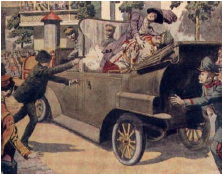Students can refer to the following Sample Paper ICSE Class 10 History Civics Set G with Answers provided below based on the latest syllabus and examination guidelines issued for ICSE History Civics. All specimen papers have been prepared covering all chapters given in ICSE History Civics book for Class 10. You should also refer to ICSE Class 10 History Civics Solutions.
Sample Paper ICSE Class 10 History Civics Set G with Answers
Subject: History / Civics (Paper I)
You will not be allowed to write during the first 15 minutes.
Answer to this paper must be written on the paper provided separately.
This time is to be spent in reading the question paper.
The time given at the head of this paper is the time allowed for writing the answers.
Attempt all questions from Part – I (Compulsory)
A total of five questions are to be attempted from Part – II. Two out of three questions
from Section A and three out of five questions from Section B.
The intended marks for the questions or parts of questions are given in brackets ( ).
PART I [30 MARKS]
Attempt all questions from this section.
Question 1
Answer the following:
a) What does Rajya Sabha known as? (1)
b) Who determines the salaries and allowances of the MPs and Ministers? (1)
c) What does Revisory Jurisdiction mean? (HC) (1)
d) Where and when was the first Lok Adalat held? (1)
e) Why are the salaries and allowances of the judges not subject to vote of Parliament? (1)
f) When can the President appoint another judge of the Supreme Court as the acting Chief Justice? (1)
g) Who determines the composition of the Cabinet? (1)
h) Who prepares and passes the Annual Budget? (1)
i) Who administers the oath of office to the President? (1)
j) What does the President emphasize in his address to both House of Parliament? (1)
Question 2
Answer the following:
a) Why did USA enter into war? (2)
b) What does Fascism mean? (2)
c) Name the countries that formed the Allied Powers. (2)
d) The three new objectives set by the UN (2)
e) Name the monthly magazine of UNESCO. Name its headquarters. (2)
f) Name the architects of NAM. (2)
g) What does Drain of Wealth mean? What did it include? (2)
h) Who was appointed as India’s first law minister in the Cabinet of Jawaharlal Nehru? What was he awarded? (2)
i) What is arms race? When did it begin? (2)
j) Who inflamed the atmosphere with revolutionary ideas in Italy? (2)
PART II [50 MARKS]
SECTION – A
Attempt any two questions from this section.
Question 3
With reference to the Union Parliament, answer the following:
a) Explain the terms-Quorum, No-Confidence Motion and Adjournment Motion. (3)
b) With reference to the Speaker, answer the following: (3)
i. His Election ii. Resignation
c) Amendment of the Constitution. (4)
Question 4
With reference to the Union Executive, answer the following:
a) Formation of the Cabinet. (3)
b) What does the principle of Collective responsibility imply? (3)
c) Position of the Prime Minister in the Parliament. (4)
Question 5
With reference to the ‘Judiciary’, answer the following:
a) What does ‘Court of Record’ mean? What are its implications? (3)
b) Qualifications required to be the judge of the Supreme Court. (3)
c) Independence of Judiciary from the control of Executive and Legislature. (4)
SECTION – B
Attempt any three questions from this section.
Question 6
National awakening in India began as a reaction of the Indians to the British colonial policies. With reference to this, answer the following:
a) The newspapers played a significant role in developing a strong national sentiment among the Indians. (3)
b) The objectives of Indian Association.
c) Consequences of the First War of Independence
Question 7
The British encouraged the Communal forces to wreck the rising tide of nationalism. With reference to this, answer the following:
a) Objectives of the Early Nationalists. (3)
b) Issues on which the two wings of the congress had differences of opinion. (3)
c) Factors responsible for the Formation of the Muslim League. (4)
Question 8
With reference to the Mass Phase of the National Movement, answer the following:
a) The three – point programme formed by the Khilafatists. (3)
b) Impact of the Non – Cooperation Movement. (3)
c) The Programme of the Civil Disobedience Movement. (4)
Question 9
Disastrous World Wars had led the world leaders from the United Nations. With reference to this, answer the following:
a) Objectives of the UN. (3)
b) Functions of UNESCO with reference to the preservation of Cultural Heritage. (3)
c) The Panchsheel Principles. (4)
Question 10
With reference to the two World Wars, answer the following:
a) i. Name the only military force that Japan had to fear. (1)
b) What were the two crucial mistakes made by the Japanese at Pearl Harbor. (2)
c) Causes for the rise of Nazism, (3)
d) Identify the event in the picture. State how it became the immediate Cause of the First World War(4)
